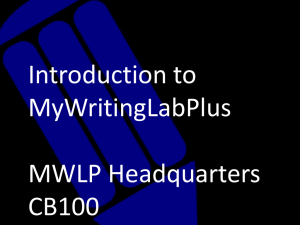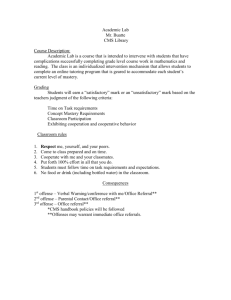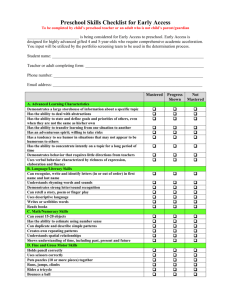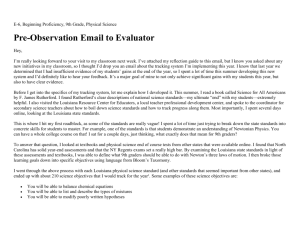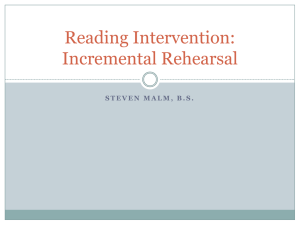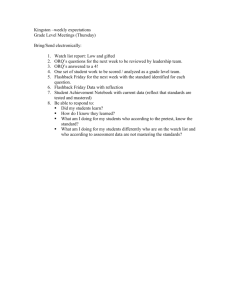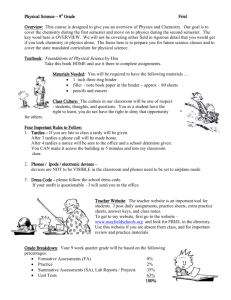Eval and Reeval Report
advertisement
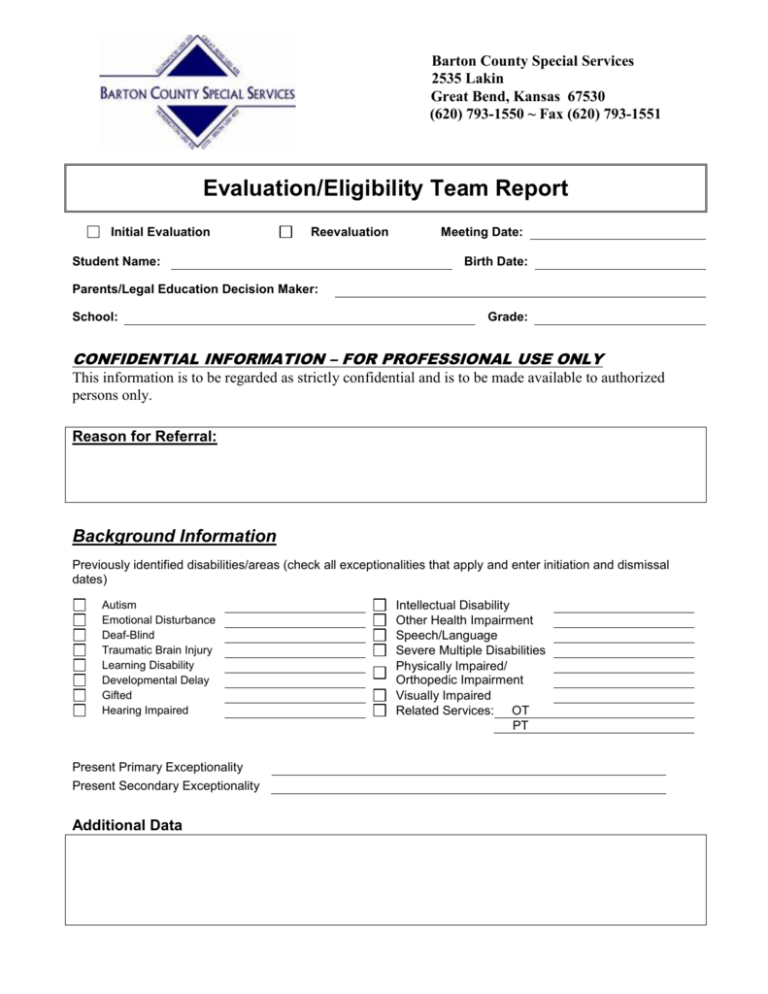
Barton County Special Services 2535 Lakin Great Bend, Kansas 67530 (620) 793-1550 ~ Fax (620) 793-1551 Evaluation/Eligibility Team Report Initial Evaluation Reevaluation Student Name: Meeting Date: Birth Date: Parents/Legal Education Decision Maker: School: Grade: CONFIDENTIAL INFORMATION – FOR PROFESSIONAL USE ONLY This information is to be regarded as strictly confidential and is to be made available to authorized persons only. Reason for Referral: Background Information Previously identified disabilities/areas (check all exceptionalities that apply and enter initiation and dismissal dates) Autism Emotional Disturbance Deaf-Blind Traumatic Brain Injury Learning Disability Developmental Delay Gifted Hearing Impaired Present Primary Exceptionality Present Secondary Exceptionality Additional Data Intellectual Disability Other Health Impairment Speech/Language Severe Multiple Disabilities Physically Impaired/ Orthopedic Impairment Visually Impaired Related Services: OT PT Evaluation Data Summary General education intervention or screening results: Record Review: Interview: Observation: (Include relevant behavior noted during the observation and the relationship of the behavior to the student’s academic functioning.) Tests: WISC-IV WJ-III Speech/Language Adapted Behavior Scales Social/Emotional Rating Scales Functional Behavioral Assessment Other: Present Levels of Educational Performance: Include current, specific, measurable objective baseline data. Health/Vision/Hearing Health can be described as: excellent Health conditions that may affect learning: good fair poor Medications: Health Plan Needed: Vision Screening Date Hearing Screening Date Pass Fail Pass Fail Comments: Evaluation/Eligibility Report, BCSS Revised August 2011 Page 2 Motor No gross/fine motor concerns Gross motor concerns: Describe Fine motor concerns; Describe This person participates in Regular PE This person participates in Regular PE with modifications This person has completed PE requirements. Comments: Behavioral and Social/Emotional Observations and Testing Short attention span; unable to concentrate; appears restless Does not complete tasks; careless and disorganized Seeks excessive attention Socially isolated; withdrawn: Describe Difficulty dealing with authority figures Self-perception: Describe: Peer Interaction: Describe Poor anger control; frustrated Strengths and/or comments: Impact on education: Evaluation/Eligibility Report, BCSS Revised August 2011 Page 3 Behavior Assessment System for Children-2nd Edition: Interpretative Guidelines for T-Scores Classification Adaptive Scales Clinical Scales Clinically Significant Very High At-Risk High Average Average At-Risk Low Clinically Significant Very Low T-Score Range 70 and above 60-69 41-59 31-40 30 and below Self-Report Clinical Scales Attitude to School Attitude to Teachers Sensation Seeking School Problems Atypicality Locus of Control Social Stress Anxiety Depression Sense of Inadequacy Somatization Internalizing Problems Attention Problems Hyperactivity Inattention/Hyperactivity Emotional Symptoms Index Adaptive Scales Relations with Parents Interpersonal Relations Self-Esteem Self-Reliance Personal Adjustment Rater Summary: Evaluation/Eligibility Report, BCSS Revised August 2011 Page 4 Parent/Teacher Report Clinical Scales Hyperactivity Aggression Conduct Problems Externalizing Problems Anxiety Depression Somatization Internalizing Problems Attention Problems Learning Problems School Problems Atypicality Withdrawal Behavioral Symptoms Index Adaptive Scales Adaptability Social Skills Leadership Study Skills Functional Communication Adaptive Skills Raters Summary: Conner’s Self Report Rating Scales: Interpretative Guidelines for T-Scores 70+ 66-70 61-65 45-60 44 to <30 Markedly atypical, indicates significant problem Moderately atypical, indicates significant problem Mildly atypical, possible significant problem Average to slightly atypical, should not raise a concern Low scores are good, should not raise a concern A. Family Problems B. Emotional Problems C. Conduct Problems D. Cognitive Problems/Inattention E. Anger Control Problems F. Hyperactivity G. ADHD Index H. DSM-IV: Inattentive I. DSM-IV: Hyperactive-Impulsive J. DSM-IV: Total Rater Evaluation/Eligibility Report, BCSS Revised August 2011 Student Page 5 Summary: Conners’ Teacher/Parent Rating Scales: Interpretative Guidelines for T-Scores 70+ 66-70 61-65 45-60 44 to <30 Markedly atypical, indicates significant problem Moderately atypical, indicates significant problem Mildly atypical, possible significant problem Average to slightly atypical, should not raise a concern Low scores are good, should not raise a concern A. Oppositional B. Cognitive Problems/ Inattention C. Hyperactivity D. Anxious/Shy E. Perfectionism F. Social Problems G. Psychosomatic (parents only) H. Conner’s' ADHD Index I. Conner’s' Global Index Restless-Impulsive J. Conner’s' Global Index Emotional Liability K. Conners' Global Index: Total L. DSM-IV: Inattentive M. DSM-IV: Hyperactive/ Impulsive N. DSM-IV: Total Raters Summary: Evaluation/Eligibility Report, BCSS Revised August 2011 Page 6 Emotional and Behavior Problems Scale-2 (Hawthorne, EBPS-2 S/PV 2001) Learning Interpersonal Relations Inappropriate Behavior Under Normal Circumstances Unhappiness/ depression Physical Symptoms/ fears Total Percentile Score SS= SS= SS= SS= SS= SS= SS= SS= SS= SS= SS= SS= SS= SS= SS= SS= SS= SS= SS= SS= SS= SS= SS= SS= SS= SS= SS= SS= SS= SS= SS= SS= SS= SS= SS= SS= SS= SS= SS= SS= % % % % % % % % Raters Summary: In Kansas State Regulations for Special Education “Emotional Disturbance” is defined as follows: “The term means a condition exhibiting one or more of the following characteristics over a long period of time and to a marked degree that adversely affects a child’s educational performance: an inability to learn that cannot be explained by intellectual, sensory, or health factors; an inability to build or maintain satisfactory interpersonal relationships with peers and teachers; inappropriate types of behavior or feelings under normal circumstances; a general pervasive mood of unhappiness or depression; and a tendency to develop physical symptoms or fears associated with personal or school problems. The term does not apply to children who are socially maladjusted, unless it is determined that they have an emotional disturbance.” In Best Practices in Assessing and Differentiating ED/SM in Children and Adolescents (MEDS-PDN), a simple guide to differentiating Emotional Disturbance from Social Maladjustment includes the following criteria: ED No SM Yes Was the behavior instrumental in obtaining some secondary gain, particularly to benefit the child or harm another person? Explain: No Yes Was the student experiencing subjective distress? Explain: Yes No Was the behavior purposeful and calculated? Explain: Evaluation/Eligibility Report, BCSS Revised August 2011 Page 7 Recommendations: No significant behavioral concerns Responds to school-wide management system Conduct a Functional Behavioral Assessment Develop a Behavior Intervention Plan Provide positive behavioral support Placement in Special Education for an Emotional Disturbance Communication No communication concerns Comments and/or concerns: Intellectual WPPSI-III Date: Verbal Performance Full Scale SB-IV Date: Verbal Reas. Abs./Visual Reas. Short Term Memory Quant. Reason. Composite SB-V Date: Nonverbal Verbal Full Scale WISC-III Date: VC Verbal PO Performance FD Full Scale PS WISC-III Date: Verbal Performance Full Scale VC PO FD PS Date: VCI PRI Full Scale WMI PSI PRI Full Scale WMI PSI WISC-IV WISC-IV Date: VCI Results: Evaluation/Eligibility Report, BCSS Revised August 2011 Page 8 Testing Observations: Strengths: Weaknesses: Educational Impact: Additional Comments: Past test results reflect present functioning Previous results are suspect; explain: Academic Achievement DAR: Print Awareness Rhyming Words Segmenting Words Hearing Initial Consonant Sounds Hearing Final Consonant Sounds Auditory Blending Naming Capital Letters Naming Lowercase Letters Matching Letters Matching Words Writing Words Consonant Sounds Consonant Blends Short Vowel Sounds Rule of Silent E Vowel Digraphs Evaluation/Eligibility Report, BCSS Revised August 2011 Mastered Mastered Mastered Mastered Mastered Mastered Mastered Mastered Mastered Mastered Mastered Mastered Mastered Mastered Mastered Mastered Not Mastered Yet Not Mastered Yet Not Mastered Yet Not Mastered Yet Not Mastered Yet Not Mastered Yet Not Mastered Yet Not Mastered Yet Not Mastered Yet Not Mastered Yet Not Mastered Yet Not Mastered Yet Not Mastered Yet Not Mastered Yet Not Mastered Yet Not Mastered Yet Not Administered Not Administered Not Administered Not Administered Not Administered Not Administered Not Administered Not Administered Not Administered Not Administered Not Administered Not Administered Not Administered Not Administered Not Administered Not Administered Page 9 Diphthongs Vowels with R Two-Syllable Words Polysyllabic Words Word Recognition Oral Reading (Accuracy) Oral Reading (Fluency) Silent Reading Comprehension Spelling Word Meaning Mastered Mastered Mastered Mastered DAR Level: DAR Level: DAR Level: DAR Level: DAR Level: DAR Level: Not Mastered Yet Not Mastered Yet Not Mastered Yet Not Mastered Yet Not Administered Not Administered Not Administered Not Administered Not Administered Not Administered AREA SS Mental Computation & Estimation -- Not Administered Not Administered Not Administered Not Administered Key Math-3: AREA SS AE Numeration --- Algebra --- Geometry --- Addition & Subtraction Multiplication & Division Measurement Data Analysis & Probability BASIC CONCEPTS --- OPERATIONS AE AREA -- Foundations of Problem Solving Applied Problem Solving -- APPLICATIONS SS AE --- --- TOTAL TEST COMPOSITE WJ-III: AREA SS AE Br. Written Language AREA SS AE Written Expression AREA SS AE Basic Writing Brief Writing Brigance Diagnostic Comprehensive Inventory of Basic Skills, Revised: AREA Quotient AE Recognizes Colors Self-Help Skills Personal Data Response Identifies Body Parts Understands Directional and Positional Concepts GENERAL KNOWLEDGE AND LANGUAGE AREA Running and Skipping Gross-Motor Skills Standing Gross-Motor Skills Walking Gross-Motor Skills GROSS-MOTOR SKILLS Joins Sets Numeral Comp. Visual Disc.-Forms, Letters, & Words Recites Alphabet Rote Counting Understands Quantitative Concepts Reads Uppercase Letters Counts Objects Reads Lowercase Letters Reads Numerals READING MATH Evaluation/Eligibility Report, BCSS Revised August 2011 Quotient AE AREA Quotient AE Draw A Person Visual Motor Skills Forms Prints Lowercase Letters in Sequence Prints Uppercase Letters Dictated Prints Lowercase Letters Dictated Prints Uppercase Letters in Sequence Prints Personal Data Writes Numerals in Sequence GRAPHOMOTOR AND WRITING SKILLS Page 10 WJ III: AREA SS AE AREA SS AE AREA Oral Language Broad Math Math Calculation Oral Expression Broad Written Lang Math Reasoning Listening Comp Basic Reading Basic Writing Broad Reading Reading Comp Written Expression SS AE SS AE SS AE WJ III: AREA SS AE AREA SS AE AREA Oral Language Broad Math Math Calculation Oral Expression Broad Written Lang Math Reasoning Listening Comp Basic Reading Basic Writing Broad Reading Reading Comp Written Expression MBA: AREA SS AE AREA Basic Skills Basic Reading Basic Writing Factual Knowledge SS AE AREA Basic Math Testing Observations: Reading: Math: Evaluation/Eligibility Report, BCSS Revised August 2011 Page 11 Writing: Social Studies: Science: Comments: Adaptive Behavior Adaptive behavior consistent with intellectual functioning Adaptive behavior Not consistent with intellectual functioning Comments: Transition/Vocational Skills Vocational Interests: Work Habits: Evaluation/Eligibility Report, BCSS Revised August 2011 Page 12 Vocational Training and Experiences: Comments: Assistive Technology Comments: BASIS for ELIGIBILITY DETERMINATION YES Question 1: Does this child exhibit an exceptionality? NO Data Sources used to support response: GEI/Screening Record Review Interview Observation Testing Discussion of how the data led you to the response: YES Question 2: Does the child need special education? Data Sources used to support response: GEI/Screening Record Review Interview Observation NO Testing Discussion of how the data led you to the response: If child is suspected of having a learning disability, the severe discrepancy is primarily the result of: Visual, hearing or motor impairment YES NO Mental retardation or emotional disturbance YES NO Environmental, cultural or economic disadvantage YES NO Exclusionary Factors The determined factor for eligibility is due to: Evaluation/Eligibility Report, BCSS Revised August 2011 Page 13 A lack of instruction in reading or mathematics Explain: YES NO Limited English Proficiency Explain: YES NO Environmental, cultural or economic disadvantage Explain: YES NO Any educationally relevant medical findings: Parent Concerns Comments: COMMITTEE RECOMMENDATIONS It is the judgment of the undersigned members of the evaluation team, including parents, that an evaluation addressing all areas of concern has been completed and: The student is eligible for special education because: The criteria as a child with an exceptionality as determined by the Cooperative’s eligibility Indicators has been met and Special education services are necessary to enable this student to receive educational benefits in accordance with his/her abilities or capabilities. Child meets the following criteria for Check the applicable box(es). AM Communication DB Vision Loss DD Physical ED Interpersonal Relationships GI Aptitude HI Hearing Loss LD Oral Expression Listening Comprehension Written Expression Basic Reading Skills Reading Fluency Skills Reading Comprehension Mathematics Calculation Mathematics Problem Solving MD At Least Two Disabilities Evaluation/Eligibility Report, BCSS Revised August 2011 Social Interaction Before age of 3 Hearing Loss Cognitive Adaptive Behavior /Emotions Achievement Communication Social/Emotional Physical Symptoms/Fears Educational Impact Matrix Educational Impact Severe Educational Needs Page 14 ID Aptitude Adaptive Behavior OHI Chronic or Acute Health Problems OI Orthopedic or Health Impairment SL Language TBI Injury to brain from external source VI Vision Loss Voice Fluency Achievement Educational impact Educational impact Articulation/Phonology Impaired functioning Educational Impact The student is not eligible for special education because: The criteria as a child with an exceptionality as determined by the Cooperative’s eligibility Indicators has not been met or Special education services are not necessary to enable this student to receive educational benefits in accordance with his/her abilities or capabilities. Child does not meet criteria for based on: . Team Members: Position Signature Date Agree Disagree Parent Parent Admin/Designee Psychologist Gen. Ed. Teacher Sp. Ed. Teacher *Minority Report: Any member of this team dissenting from the final team recommendations may (and in the case of a student being considered fro a learning disability, must) present, in writing, his or her recommendations and/or the reason(s) for disagreeing with the decision. Evaluation/Eligibility Report, BCSS Revised August 2011 Page 15 I certify that a comprehensive evaluation has been completed for the student. _____________________________________ Director of Special Services Date:___________________________ The school psychologist reviewed the results of the comprehensive evaluation including test scores, summary and recommendations for my child and I have received a copy of the evaluation. The school staff has discussed and I have been given information on the process of guardianship and conservatorship (effective when student turns 18 years of age). __________________________________ (Psychologist’s Signature) ___________________________________ (Parent’s Signature) __________________________________ (Date) ___________________________________ (Date) Evaluation/Eligibility Report, BCSS Revised August 2011 Page 16
